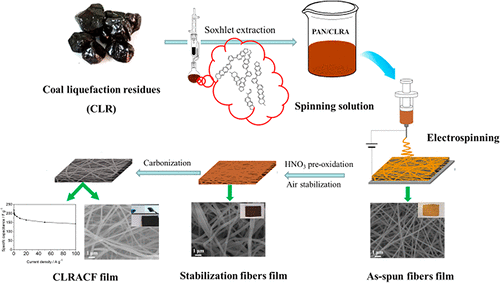当前位置:
X-MOL 学术
›
ACS Sustain. Chem. Eng.
›
论文详情
Our official English website, www.x-mol.net, welcomes your
feedback! (Note: you will need to create a separate account there.)
Coal Liquefaction Residues Based Carbon Nanofibers Film Prepared by Electrospinning: An Effective Approach to Coal Waste Management
ACS Sustainable Chemistry & Engineering ( IF 7.1 ) Pub Date : 2019-02-25 00:00:00 , DOI: 10.1021/acssuschemeng.8b05210
Xiao Li 1, 2 , Xiaodong Tian 1 , Tao Yang 1, 2 , Yiting He 1, 2 , Wenhong Liu 1 , Yan Song 1 , Zhanjun Liu 1
ACS Sustainable Chemistry & Engineering ( IF 7.1 ) Pub Date : 2019-02-25 00:00:00 , DOI: 10.1021/acssuschemeng.8b05210
Xiao Li 1, 2 , Xiaodong Tian 1 , Tao Yang 1, 2 , Yiting He 1, 2 , Wenhong Liu 1 , Yan Song 1 , Zhanjun Liu 1
Affiliation

|
As a major byproduct of direct coal liquefaction, coal liquefaction residue (CLR) waste is environmentally harmful but also valuable. Considering environmental and economic efficiency, exploiting these wastes as electrodes for new generation energy storage devices will increase the economic value and decrease environmental pollution synchronously. In this regard, CLRs are used to prepare carbon nanofibers film for supercapacitors via electrospinning followed by HNO3 preoxidization, air stabilization, and carbonization processes for the first time. The influences of HNO3 preoxidization over the formation of fiber morphology, textural structure, surface chemistry, and electrochemical performance are investigated. Our work demonstrates that HNO3 preoxidization can enhance the content of the heteroatom of the as-spun nanofibers and promote the polymerization of the asphaltene (CLRA) molecular during air stabilization, leading to the changes of the thermal behaviors and thus avoiding the fibers melting successfully. The results show that the obtained sample exhibits a 3D nonwoven network with an average diameter of 200 nm, good flexibility, high content of nitrogen, and large specific surface area. Owing to these merits, the as-obtained sample shows high specific capacitance, excellent rate capability (143 F g–1 at 100 A g–1), and long lifespan (98% of its initial capacitance after 10 000 cycles) as supercapacitor electrode.
中文翻译:

静电纺丝制备煤液化残渣基碳纳米纤维薄膜:一种有效的煤炭废物管理方法
作为直接煤炭液化的主要副产品,煤炭液化残渣(CLR)废物对环境有害,但也很有价值。考虑到环境和经济效率,将这些废物用作新一代储能设备的电极将增加经济价值,并同时减少环境污染。在这方面,CLRs首次通过静电纺丝,然后进行HNO 3预氧化,空气稳定和碳化过程用于超级电容器的碳纳米纤维薄膜的制备。研究了HNO 3预氧化对纤维形态,织构,表面化学和电化学性能的影响。我们的工作表明HNO 3预氧化可以提高初生纳米纤维杂原子的含量,并在空气稳定过程中促进沥青质(CLRA)分子的聚合,从而导致热行为发生变化,从而避免纤维成功熔融。结果表明,获得的样品表现出具有平均直径为200nm的3D非织造网络,良好的柔韧性,高的氮含量和大的比表面积。由于这些优点,作为所述得到的样品显示出高的比电容,优异的倍率性能(143 F G -1在100克-1),和长寿命(10 000次循环后其初始电容的98%),为超级电容器电极。
更新日期:2019-02-25
中文翻译:

静电纺丝制备煤液化残渣基碳纳米纤维薄膜:一种有效的煤炭废物管理方法
作为直接煤炭液化的主要副产品,煤炭液化残渣(CLR)废物对环境有害,但也很有价值。考虑到环境和经济效率,将这些废物用作新一代储能设备的电极将增加经济价值,并同时减少环境污染。在这方面,CLRs首次通过静电纺丝,然后进行HNO 3预氧化,空气稳定和碳化过程用于超级电容器的碳纳米纤维薄膜的制备。研究了HNO 3预氧化对纤维形态,织构,表面化学和电化学性能的影响。我们的工作表明HNO 3预氧化可以提高初生纳米纤维杂原子的含量,并在空气稳定过程中促进沥青质(CLRA)分子的聚合,从而导致热行为发生变化,从而避免纤维成功熔融。结果表明,获得的样品表现出具有平均直径为200nm的3D非织造网络,良好的柔韧性,高的氮含量和大的比表面积。由于这些优点,作为所述得到的样品显示出高的比电容,优异的倍率性能(143 F G -1在100克-1),和长寿命(10 000次循环后其初始电容的98%),为超级电容器电极。































 京公网安备 11010802027423号
京公网安备 11010802027423号